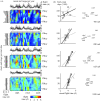Stochastic atmospheric assistance and the use of emergency staging sites by migrants
- PMID: 20071381
- PMCID: PMC2871836
- DOI: 10.1098/rspb.2009.2112
Stochastic atmospheric assistance and the use of emergency staging sites by migrants
Abstract
Numerous animals move vast distances through media with stochastic dynamic properties. Avian migrants must cope with variable wind speeds and directions en route, which potentially jeopardize fine-tuned migration routes and itineraries. We show how unpredictable winds affect flight times and the use of an intermediate staging site by red knots (Calidris canutus canutus) migrating from west Africa to the central north Siberian breeding areas via the German Wadden Sea. A dynamic migration model incorporating wind conditions during flight shows that flight durations between Mauritania and the Wadden Sea vary between 2 and 8 days. The number of birds counted at the only known intermediate staging site on the French Atlantic coast was strongly positively correlated with simulated flight times. In addition, particularly light-weight birds occurred at this location. These independent results support the idea that stochastic wind conditions are the main driver of the use of this intermediate stopover site as an emergency staging area. Because of the ubiquity of stochastically varying media, we expect such emergency habitats to exist in many other migratory systems, both airborne and oceanic. Our model provides a tool to quantify the effect of winds and currents en route.
Figures


Similar articles
-
Many routes lead to Rome: potential causes for the multi-route migration system of Red Knots, Calidris canutus Islandica.Ecology. 2010 Jun;91(6):1822-31. doi: 10.1890/09-1281.1. Ecology. 2010. PMID: 20583722
-
Wind-associated detours promote seasonal migratory connectivity in a flapping flying long-distance avian migrant.J Anim Ecol. 2020 Feb;89(2):635-646. doi: 10.1111/1365-2656.13112. Epub 2019 Oct 18. J Anim Ecol. 2020. PMID: 31581321
-
Body condition explains migratory performance of a long-distance migrant.Proc Biol Sci. 2017 Nov 15;284(1866):20171374. doi: 10.1098/rspb.2017.1374. Proc Biol Sci. 2017. PMID: 29093218 Free PMC article.
-
The role of wind-tunnel studies in integrative research on migration biology.Integr Comp Biol. 2010 Sep;50(3):323-35. doi: 10.1093/icb/icq063. Epub 2010 May 27. Integr Comp Biol. 2010. PMID: 21558207 Review.
-
The East Asian Insect Flyway: Geographical and Climatic Factors Driving Migration Among Diverse Crop Pests.Annu Rev Entomol. 2025 Jan;70(1):1-22. doi: 10.1146/annurev-ento-012524-124018. Epub 2024 Dec 19. Annu Rev Entomol. 2025. PMID: 39499909 Review.
Cited by
-
Ecophysiology of avian migration in the face of current global hazards.Philos Trans R Soc Lond B Biol Sci. 2012 Jun 19;367(1596):1719-32. doi: 10.1098/rstb.2012.0008. Philos Trans R Soc Lond B Biol Sci. 2012. PMID: 22566678 Free PMC article. Review.
-
Grand challenges in migration biology.Integr Comp Biol. 2010 Sep;50(3):261-79. doi: 10.1093/icb/icq013. Epub 2010 Apr 21. Integr Comp Biol. 2010. PMID: 21558203 Free PMC article.
-
Low migratory connectivity and similar migratory strategies in a shorebird with contrasting wintering population trends in Europe and West Africa.Sci Rep. 2024 Feb 28;14(1):4884. doi: 10.1038/s41598-024-55501-y. Sci Rep. 2024. PMID: 38418600 Free PMC article.
-
Influence of weather conditions on the flight of migrating black storks.Proc Biol Sci. 2010 Sep 22;277(1695):2755-64. doi: 10.1098/rspb.2010.0422. Epub 2010 Apr 28. Proc Biol Sci. 2010. PMID: 20427337 Free PMC article.
-
Swainson's Thrushes do not show strong wind selectivity prior to crossing the Gulf of Mexico.Sci Rep. 2017 Oct 27;7(1):14280. doi: 10.1038/s41598-017-14668-3. Sci Rep. 2017. PMID: 29079749 Free PMC article.
References
-
- Åkesson S., Hedenström A.2000Wind selectivity of migratory flight departures in birds. Behav. Ecol. Sociobiol. 47, 140–144
-
- Åkesson S., Walinder G., Karlsson L., Ehnbom S.2002Nocturnal migratory flight initiation in reed warblers Acrocephalus scirpaceus: effect of wind on orientation and timing of migration. J. Avian Biol. 33, 349–357 (doi:10.1034/j.1600-048X.2002.02951.x) - DOI
-
- Alerstam T., Hedenström A.1998The development of bird migration theory. J. Avian Biol. 29, 343–369 (doi:10.2307/3677155) - DOI
-
- Anonymous 1976US Standard Atmosphere Washington, DC, USA: Government Printing Office
-
- Bauer S., van Dinther M., Høgda K.-A., Klaassen M., Madsen J.2008The consequences of climate-driven stop-over site changes on migration schedules and fitness of Arctic geese. J. Anim. Ecol. 77, 654–660 (doi:10.1111/j.1365-2656.2008.01381.x) - DOI - PubMed
Publication types
MeSH terms
LinkOut - more resources
Full Text Sources
Research Materials

